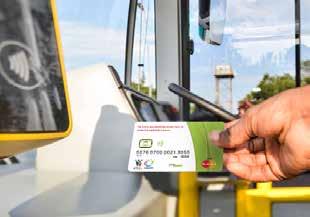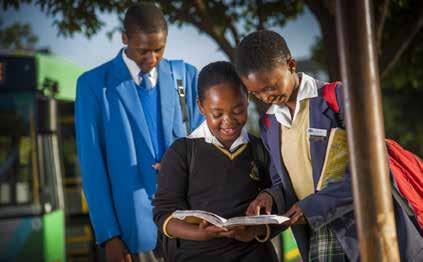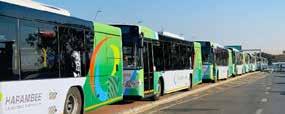
6 minute read
INTEGRATED PUBLIC TRANSPORT Connecting Ekurhuleni
by 3S Media
CONNECTING EKURHULENI

Advertisement

Ekurhuleni’s geospatial make-up – with its nine disparate towns and 1 975 km2 area – poses a significant challenge to the movement of people, which is why the City has committed to establishing an integrated rapid public transit network that will improve quality of life through ease of access.
Ekurhuleni’s large land mass is characterised by varying degrees in availability of transport, differing rates of industrial and human settlements development, as well as a lack of alignment in historical spatial planning – attributes common among South Africa’s major cities. As such, there is a distinct need to capitalise on all transport modes to form an integrated transport backbone that service’s the City’s communities. The City has set out the following priorities in its effort to promote and integrate human settlements through various massive infrastructure and services roll-outs, as prescribed by the Growth and Development Strategy 2055’s Re-urbanise theme, which seeks to achieve urban integration. Key to this is the City’s integrated rapid public transit network (IRPTN). IMPLEMENTATION OF THE IRPTN The heartbeat of Ekurhuleni’s IRPTN is the Harambee bus rapid transport (BRT) system, which has seen significant progress since it first opened its doors to passengers in October 2017.
The Harambee BRT services an area stretching from Tembisa in the north to Isando at one southern end and O.R. Tambo International Airport at


ABOUT HARAMBEE BRT
Harambee in Swahili means working together. The Harambee system is just another example of how the City of Ekurhuleni is dedicated to providing a sustainable and people-centred developmental service that is affordable, appropriate and of high quality. This service is focused on the social, environmental and economic regeneration of our city and communities. The IRPTN – with Harambee as its heartbeat – will connect people of Ekurhuleni with their jobs, schools, families and many more. This will be done by integrating all forms of transport (walking, cycling, taxis, trains, etc.) into the Harambee system. The IRPTN will assist in connecting Ekurhuleni to create a unified metropolitan city that will work together in order to better the lives of all of its residents.


the end of the other arterial route. A proposed service extension to Bartlett, south of the aerotropolis, was delayed due to the Covid-19-induced national lockdown, which led to the suspension of all bus services. The route extension to Bartlett terminates at the Springbok/ Taljaard intersection in the vicinity of the RTT Courier Company just north of the N12 National highway, fully covering the industrial area.
Like many leading BRT services across the world, Harambee makes use of reusable bus tickets in the form of the Harambee Card, which allows commuters to “top up, tap in and tap out” in the quickest, most efficient and safest way, reducing the need for them to make regular trips to Harambee mobile kiosks to purchase new tickets.
The Harambee Card is reloadable, reliable and reusable, enabling commuters to load money on it so they can travel more safely and conveniently. The Harambee Card will assist in modernising and transforming the public transport system within the City of Ekurhuleni, as it is set to be an integrated payment solution that for other affiliate bus services within Ekurhuleni.
SUSTAINABLE SOLUTIONS For it to be a total success, Harambee must not only be efficient but sustainable as well. This is exemplified by the acquisition of diesel buses that feature Euro V emissions technology, which puts the transport system at the cutting edge of improved air quality and environmental sustainability by reducing pollution. Addressing these environmentally conscious buses, MMC for Transport and Fleet Phelisa Nkunjana said, “European emissions standards define the acceptable limits for exhaust emissions of new vehicles sold in the EU. In Europe, the vehicles are required to have an engine that meets certain environmental standards in order to reduce atmospheric pollutants such as particulates and nitrogen oxide. Ekurhuleni is one of the first cities in Africa to have a transport system that promotes good air quality. We are a City that is leading the pack in supporting efforts towards environmental sustainability through the reduction of pollution.”
COMPLEMENTARY SERVICES The City also provides another bus service – the Ekurhuleni Bus Service – which is a well-established service that operates from two depots in Germiston and Boksburg. The service continues to attract patronage from the residents, boasting upwards of a million passengers per annum. This service and the Harambee BRT system are intended to operate as complementary services to move commuters around the City in a safe and efficient manner.
The City of Ekurhuleni is committed to working with the taxi industry and has developed a partnership that seeks to reduce fragmentation of accountability and enhance the role taxis play in the public transport mix. This partnership reinforces the importance of taxi rank allocation and seeks to provide visible, safe and secure taxi ranks that are easily accessible. In its endeavour to provide access to public transport in Ekurhuleni, the City is in the process of completing the construction of both the Bluegum View and the New Vosloorus public transport facilities.
COVID-19 CHALLENGES AND SUCCESSES Although faced with challenges imposed by national lockdown restrictions, the City has progressed well in the implementation if IRPTN infrastructure projects. The City had planned to complete the construction of nine new bus stations under Phase 1A, of which two has reached practical completion in Q4 of the 2019/20 financial year. The remaining seven were anticipated to be completed in Q2 of the 2020/21 financial year. The required bus stops were constructed along the route and an additional 6 km of pedestrian and cyclist paths (non-motorised transport infrastructure) have been completed.
The pursuit of achieving integrated human settlements through the roll-out of massive infrastructure and services remains a key strategic objective for the Transport and Fleet Management Department. The past financial year presented social and economic challenges caused by the novel coronavirus pandemic, which affected the department’s ability to carry out its planned operations.
Though presented with numerous challenges, the department achieved more than 70% of its predetermined objectives, thereby utilising over 85% of the allocated capital budget. This was attributed by efficient utilisation of the infrastructure grants afforded to the department through the IRPTN project and the effective management of contractual arrangements with contractors and suppliers.
SIYAZI

SIYAZI is a registered member of the Engineering Council of South Africa (ECSA).

PUBLIC TRANSPORT PLANNING:






Operating licence strategies (OLSs) Public transport plans Integrated transport plans: Freight, public transport (taxis, buses and private cars) Needs determination of users and operators System design Taxi rank and bus terminus design Taxi industry facilitation Taxi rank management strategies Determine transportation vision, goals and objectives on various spheres of government Policy development Modal integration strategies Taxi recapitalisation plans
TRAFFIC ENGINEERING:
COMMUNITY INVOLVEMENT:
Impact studies for developments such as shopping centres, filling stations and residential areas Setting and synchronisation of traffic lights Parking studies, including issues such as parking layout, parking demand and parking supply Designs for pedestrian and bicycle facilities
Academing empowerment of students Blankets for gogos















